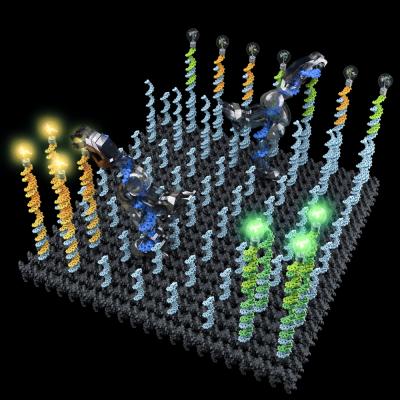While its feet may wander aimlessly, its hand won’t pick up just anything. Neither will it release its finds willy nilly. “It” is a molecular robot, a single-stranded DNA with one leg and two foot domains for walking, and one arm and one hand domain for picking up and dropping off cargos. And it doesn’t necessarily walk alone. It may mill about a two-dimensional surface with its peers, who may have their preferences for what they pick up, and where they release their finds.
The two-dimensional surface upon which the DNA robot roams is a “playground,” say the DNA robot’s creators, a 58-nanometer-by-58-nanometer pegboard on which the pegs are made of single strands of DNA complementary to the robot’s leg and foot. The robot binds to a peg with its leg and one of its feet—the other foot floats freely. When random molecular fluctuations cause this free foot to encounter a nearby peg, it pulls the robot to the new peg and its other foot is freed. This process continues with the robot moving in a random direction at each step.
It may take a day for a robot to explore the entire board. Along the way, as the robot encounters cargo molecules tethered to pegs, it grabs them with its “hand” components and carries them around until it detects the signal of the drop-off point. The process is slow, but it allows for a very simple robot design that utilizes very little chemical energy.
The robot strolled out of the laboratory of Lulu Qian, Ph.D., an assistant professor of bioengineering at the California Institute of Technology. According to Dr. Qian, her team hasn’t built the robot to accomplish any particular task. Instead, she sees the robot as a general-purpose device, one that can be adapted to diverse tasks.
“Our lab focuses on discovering the engineering principles,” explained Dr. Qian. “It is my hope that other researchers could use these principles for exciting applications, such as using a DNA robot for synthesizing a therapeutic chemical from its constituent parts in an artificial molecular factory, delivering a drug only when a specific signal is given in bloodstreams or cells, or sorting molecular components in trash for recycling.”
The principles emphasized in the lab’s current work are modularity and algorithm simplicity. Specifically, the lab has used three modular building blocks to assemble its DNA robot. The lab has also designed a simple algorithm that encodes recognition between cargos and their destinations, and allows for a simple robot design.
Details appeared September 15 in the journal Science, in an article entitled “A Cargo-Sorting DNA Robot.” This article points out that the development of DNA robots has been limited to simple functions, and that most DNA robots have been designed to perform a single function—walking in a controlled direction. To overcome these limitations, the Qian lab not only emphasized modularity and algorithm simplicity, they introduced another key element: parallelism.
“The robot explores a two-dimensional testing ground on the surface of DNA origami, picks up multiple cargos of two types that are initially at unordered locations, and delivers them to specified destinations until all molecules are sorted into two distinct piles,” wrote the article’s authors. “The robot is designed to perform a random walk without any energy supply. Exploiting this feature, a single robot can repeatedly sort multiple cargos. Localization on DNA origami allows for distinct cargo-sorting tasks to take place simultaneously in one test tube or for multiple robots to collectively perform the same task.”
The robot explored a molecular surface, picked up two different molecules—a fluorescent yellow dye and a fluorescent pink dye—and then distributed them to two distinct regions on the surface. Using fluorescent molecules enabled the researchers to see if the molecules ended up in their intended locations. The robot successfully sorted six scattered molecules, three pink and three yellow, into their correct places in 24 hours. Adding more robots to the surface shortened the time it took to complete the task.
“Using exactly the same robot design, the system could be generalized to multiple types of cargos with arbitrary initial distributions, and to many instances of distinct tasks in parallel, whereas each task can be assigned a distinct number of robots depending on the difficulty of the task,” the article’s authors added. “With simple communication between the robots, they could perform even more sophisticated tasks. With more effort in developing modular and collective molecular robots, and with simple and systematic approaches, molecular robots could eventually be easily programmed like macroscopic robots, but working in microscopic environments.”



